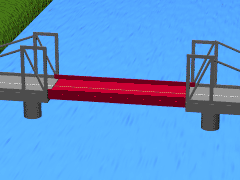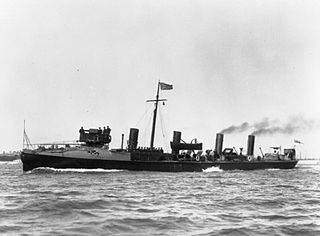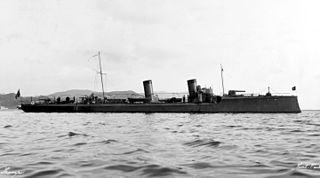Turtleback is the common name for plants in the genus Psathyrotes.
Turtleback may also refer to:
Turtleback is the common name for plants in the genus Psathyrotes.
Turtleback may also refer to:

An aircraft carrier is a warship that serves as a seagoing airbase, equipped with a full-length flight deck and facilities for carrying, arming, deploying, and recovering aircraft. Typically, it is the capital ship of a fleet, as it allows a naval force to project air power worldwide without depending on local bases for staging aircraft operations. Carriers have evolved since their inception in the early twentieth century from wooden vessels used to deploy balloons to nuclear-powered warships that carry numerous fighters, strike aircraft, helicopters, and other types of aircraft. While heavier aircraft such as fixed-wing gunships and bombers have been launched from aircraft carriers, these aircraft have not landed on a carrier. By its diplomatic and tactical power, its mobility, its autonomy and the variety of its means, the aircraft carrier is often the centerpiece of modern combat fleets. Tactically or even strategically, it replaced the battleship in the role of flagship of a fleet. One of its great advantages is that, by sailing in international waters, it does not interfere with any territorial sovereignty and thus obviates the need for overflight authorizations from third-party countries, reduces the times and transit distances of aircraft and therefore significantly increases the time of availability on the combat zone.

A suspension bridge is a type of bridge in which the deck is hung below suspension cables on vertical suspenders. The first modern examples of this type of bridge were built in the early 1800s. Simple suspension bridges, which lack vertical suspenders, have a long history in many mountainous parts of the world.

Ship models or model ships are scale models of ships. They can range in size from 1/6000 scale wargaming miniatures to large vessels capable of holding people.

In playing cards, a suit is one of the categories into which the cards of a deck are divided. Most often, each card bears one of several pips (symbols) showing to which suit it belongs; the suit may alternatively or additionally be indicated by the color printed on the card. The rank for each card is determined by the number of pips on it, except on face cards. Ranking indicates which cards within a suit are better, higher or more valuable than others, whereas there is no order between the suits unless defined in the rules of a specific card game. In a single deck, there is exactly one card of any given rank in any given suit. A deck may include special cards that belong to no suit, often called jokers.

Ginowan is a city located in Okinawa Prefecture, Japan. As of 2024, the city has an estimated population of 100,319, with 47,490 households and a population density of 5,142 persons per km2. The total area is 19.51 km2.
Deck may refer to:

The Yu-Gi-Oh! Trading Card Game is a collectible card game developed and published by Konami. It is based on the fictional game of Duel Monsters created by manga artist Kazuki Takahashi, which appears in portions of the manga franchise Yu-Gi-Oh! and is the central plot device throughout its various anime adaptations and spinoff series.

Pyramid is a patience or solitaire game of the Simple Addition family, where the object is to get all the cards from the pyramid to the foundation.

A vertical-lift bridge or just lift bridge is a type of movable bridge in which a span rises vertically while remaining parallel with the deck.
A suspension bridge supports its structural load with cables, ropes, or chains anchored at each end. Cables on the earliest suspension bridges were anchored in the ground; some modern suspension bridges anchor the cables to the ends of the bridge itself. Earliest suspension bridges had no towers or piers but the majority of larger modern suspension bridges have them. All of the 14 longest bridges in the world are suspension bridges.

The River-class destroyer was a class of torpedo boat destroyer built for the Royal Navy in the first few years of the 20th century, and which saw extensive service in World War I. These 37 vessels were all constructed to disparate builders' designs, just like the preceding classes.
Shuffling is a procedure used to randomize a deck of playing cards.
The steamboat Ticonderoga is one of two remaining side-paddle-wheel passenger steamers with a vertical beam engine of the type that provided freight and passenger service on America's bays, lakes and rivers from the early 19th to the mid-20th centuries. Commissioned by the Champlain Transportation Company, Ticonderoga was built in 1906 at the Shelburne Shipyard in Shelburne, Vermont on Lake Champlain.

An amphibious assault ship is a type of amphibious warfare ship employed to land and support ground forces on enemy territory during an amphibious assault. The design evolved from aircraft carriers converted for use as helicopter carriers. Modern designs support amphibious landing craft, with most designs including a well deck. Like the aircraft carriers they were developed from, some amphibious assault ships also support V/STOL fixed-wing aircraft and have a secondary role as aircraft carriers.

Two Ferret-class destroyers served with the Royal Navy. Ferret and Lynx were built by Laird, displaced 280 tons and were 199 feet (61 m) in overall length.

Turtleback Mountain is a 2,203-foot (671 m) mountain in the Ossipee Mountains located in Carroll County, New Hampshire, standing above Bald Knob. The summit features columnar jointing and was once home to an observation tower.

Turtleback or Turtle-back tombs or turtle shell tombs are a particular type of tombs originating from the Song Dynasty. They are commonly found in some coastal provinces of southern China, the Ryukyu Islands of Japan, and in Vietnam. They can also be found in countries with overseas Chinese populations like Malaysia.

HMS Ariel was a two funnel, 30 knot destroyer ordered by the Royal Navy under the 1895 – 1896 Naval Estimates. Named after Shakespeare's "airy spirit", or the biblical spirit of the same name, she was the ninth ship of the name to serve in the Royal Navy. She was launched in 1897, served at Chatham and Malta, and was wrecked in a storm in 1907.

The Lampo class was a class of six destroyers of the Italian Regia Marina built by the German Schichau shipyard from 1899–1901. They served in the Italo-Turkish War and the surviving ships in the First World War, before being disposed of between 1920 and 1924.

The Nembo class was a class of destroyer of the Italian Regia Marina. Six destroyers were built by the Pattison shipyard of Naples between 1899 and 1905, to a design based on the contemporary destroyers of the British shipyard Thornycroft. They were active in the Italo-Turkish War and in the First World War, where three were lost.